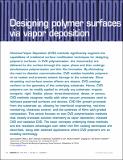Designing polymer surfaces via vapor deposition
Author(s)
Asatekin, Ayse; Barr, Miles C.; Baxamusa, Salmaan H.; Lau, Kenneth K.S.; Tenhaeff, Wyatt; Xu, Jingjing; Gleason, Karen K.; ... Show more Show less
DownloadAsatekin-2010-Designing polymer surfaces.pdf (1.227Mb)
PUBLISHER_CC
Publisher with Creative Commons License
Creative Commons Attribution
Terms of use
Metadata
Show full item recordAbstract
Chemical Vapor Deposition (CVD) methods significantly augment the capabilities of traditional surface modification techniques for designing polymeric surfaces. In CVD polymerization, the monomer(s) are delivered to the surface through the vapor phase and then undergo simultaneous polymerization and thin film formation. By eliminating the need to dissolve macromolecules, CVD enables insoluble polymers to be coated and prevents solvent damage to the substrate. Since de-wetting and surface tension effects are absent, CVD coatings conform to the geometry of the underlying substrate. Hence, CVD polymers can be readily applied to virtually any substrate: organic, inorganic, rigid, flexible, planar, three-dimensional, dense, or porous. CVD methods integrate readily with other vacuum processes used to fabricate patterned surfaces and devices. CVD film growth proceeds from the substrate up, allowing for interfacial engineering, real-time monitoring, thickness control, and the synthesis of films with graded composition. This article focuses on two CVD polymerization methods that closely translate solution chemistry to vapor deposition; initiated CVD and oxidative CVD. The basic concepts underlying these methods and the resultant advantages over other thin film coating techniques are described, along with selected applications where CVD polymers are an enabling technology.
Date issued
2010-04Department
Massachusetts Institute of Technology. Department of Chemical EngineeringJournal
Materials Today
Publisher
Elsevier
Citation
Asatekin, Ayse, Miles C. Barr, Salmaan H. Baxamusa, Kenneth K.S. Lau, Wyatt Tenhaeff, Jingjing Xu, and Karen K. Gleason. “Designing Polymer Surfaces via Vapor Deposition.” Materials Today 13, no. 5 (May 2010): 26–33. © 2010 Elsevier Ltd.
Version: Final published version
ISSN
13697021